Knowledge Management Report: Challenges and Solutions
VerifiedAdded on 2022/11/14
|9
|2189
|123
Report
AI Summary
This report delves into the multifaceted realm of knowledge management (KM), emphasizing its crucial role in organizational success. It begins by defining KM as the process of collecting, managing, and sharing employee knowledge across an organization, highlighting its impact on business processes and the elimination of redundancies. The report underscores the strategic significance of KM, citing research that indicates its importance for achieving organizational goals. It then outlines the key components of KM, including technology, people, and processes, while also addressing the challenges organizations face, such as knowledge acquisition, modeling, retrieval, and publishing. The report emphasizes the need for a cultural shift towards knowledge sharing and collaboration, along with the implementation of reward systems and recognition to encourage employee engagement. Furthermore, the report discusses the relevance of the article to course materials, reinforcing key concepts and providing additional insights into effective KM strategies. The conclusion reiterates the importance of integrating KM solutions, emphasizing the need for a multidisciplinary approach and clear objectives to ensure its success.
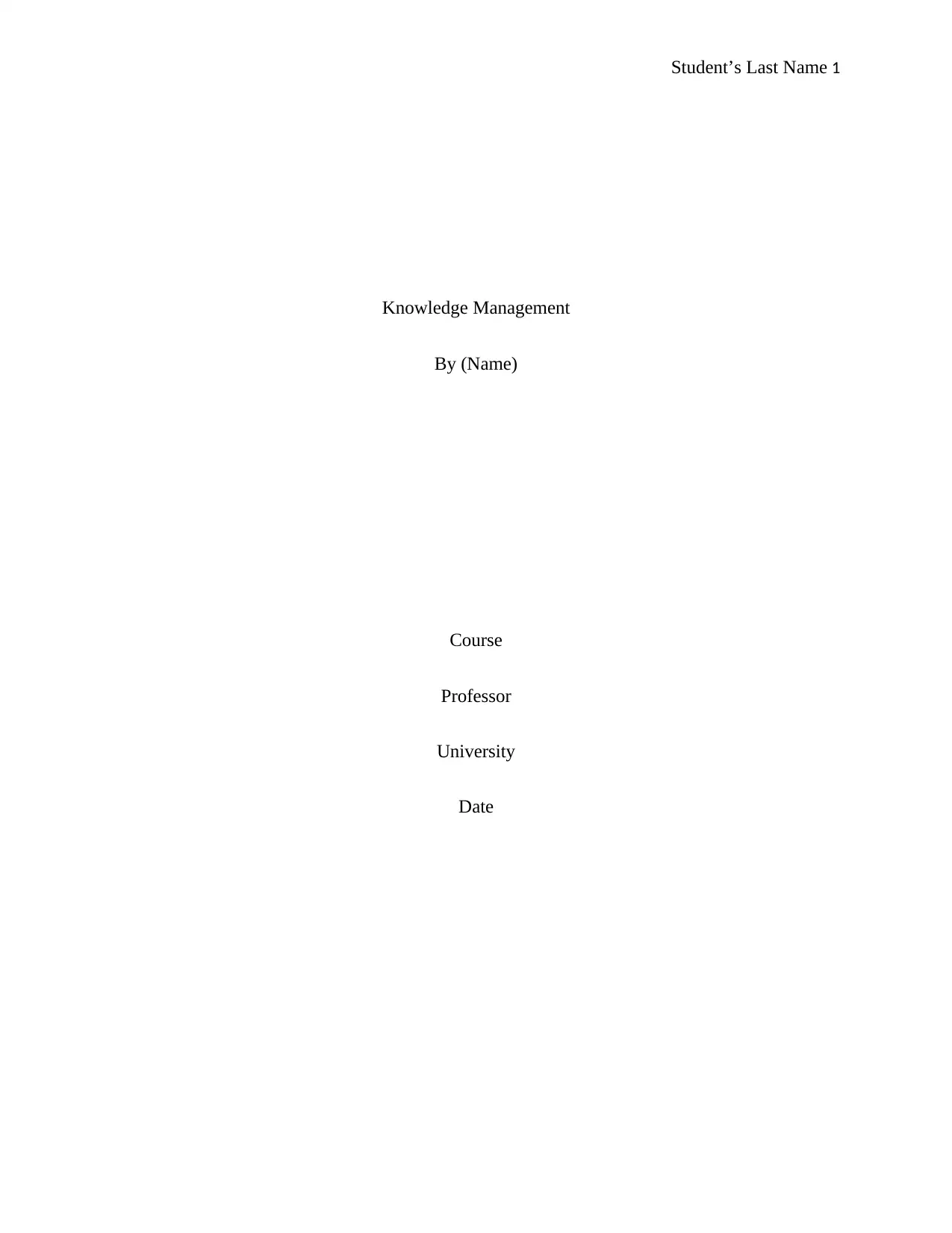
Student’s Last Name 1
Knowledge Management
By (Name)
Course
Professor
University
Date
Knowledge Management
By (Name)
Course
Professor
University
Date
Paraphrase This Document
Need a fresh take? Get an instant paraphrase of this document with our AI Paraphraser
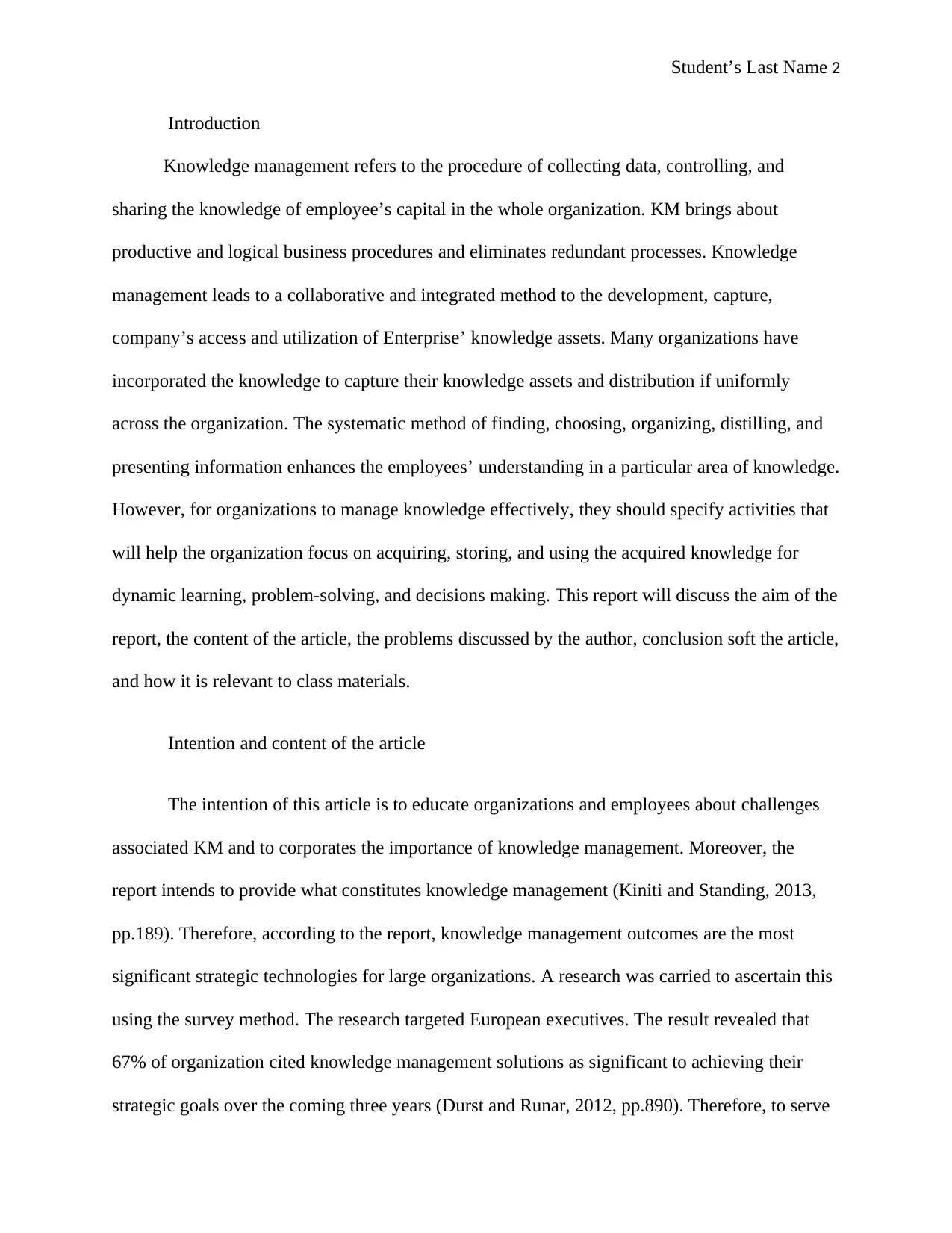
Student’s Last Name 2
Introduction
Knowledge management refers to the procedure of collecting data, controlling, and
sharing the knowledge of employee’s capital in the whole organization. KM brings about
productive and logical business procedures and eliminates redundant processes. Knowledge
management leads to a collaborative and integrated method to the development, capture,
company’s access and utilization of Enterprise’ knowledge assets. Many organizations have
incorporated the knowledge to capture their knowledge assets and distribution if uniformly
across the organization. The systematic method of finding, choosing, organizing, distilling, and
presenting information enhances the employees’ understanding in a particular area of knowledge.
However, for organizations to manage knowledge effectively, they should specify activities that
will help the organization focus on acquiring, storing, and using the acquired knowledge for
dynamic learning, problem-solving, and decisions making. This report will discuss the aim of the
report, the content of the article, the problems discussed by the author, conclusion soft the article,
and how it is relevant to class materials.
Intention and content of the article
The intention of this article is to educate organizations and employees about challenges
associated KM and to corporates the importance of knowledge management. Moreover, the
report intends to provide what constitutes knowledge management (Kiniti and Standing, 2013,
pp.189). Therefore, according to the report, knowledge management outcomes are the most
significant strategic technologies for large organizations. A research was carried to ascertain this
using the survey method. The research targeted European executives. The result revealed that
67% of organization cited knowledge management solutions as significant to achieving their
strategic goals over the coming three years (Durst and Runar, 2012, pp.890). Therefore, to serve
Introduction
Knowledge management refers to the procedure of collecting data, controlling, and
sharing the knowledge of employee’s capital in the whole organization. KM brings about
productive and logical business procedures and eliminates redundant processes. Knowledge
management leads to a collaborative and integrated method to the development, capture,
company’s access and utilization of Enterprise’ knowledge assets. Many organizations have
incorporated the knowledge to capture their knowledge assets and distribution if uniformly
across the organization. The systematic method of finding, choosing, organizing, distilling, and
presenting information enhances the employees’ understanding in a particular area of knowledge.
However, for organizations to manage knowledge effectively, they should specify activities that
will help the organization focus on acquiring, storing, and using the acquired knowledge for
dynamic learning, problem-solving, and decisions making. This report will discuss the aim of the
report, the content of the article, the problems discussed by the author, conclusion soft the article,
and how it is relevant to class materials.
Intention and content of the article
The intention of this article is to educate organizations and employees about challenges
associated KM and to corporates the importance of knowledge management. Moreover, the
report intends to provide what constitutes knowledge management (Kiniti and Standing, 2013,
pp.189). Therefore, according to the report, knowledge management outcomes are the most
significant strategic technologies for large organizations. A research was carried to ascertain this
using the survey method. The research targeted European executives. The result revealed that
67% of organization cited knowledge management solutions as significant to achieving their
strategic goals over the coming three years (Durst and Runar, 2012, pp.890). Therefore, to serve
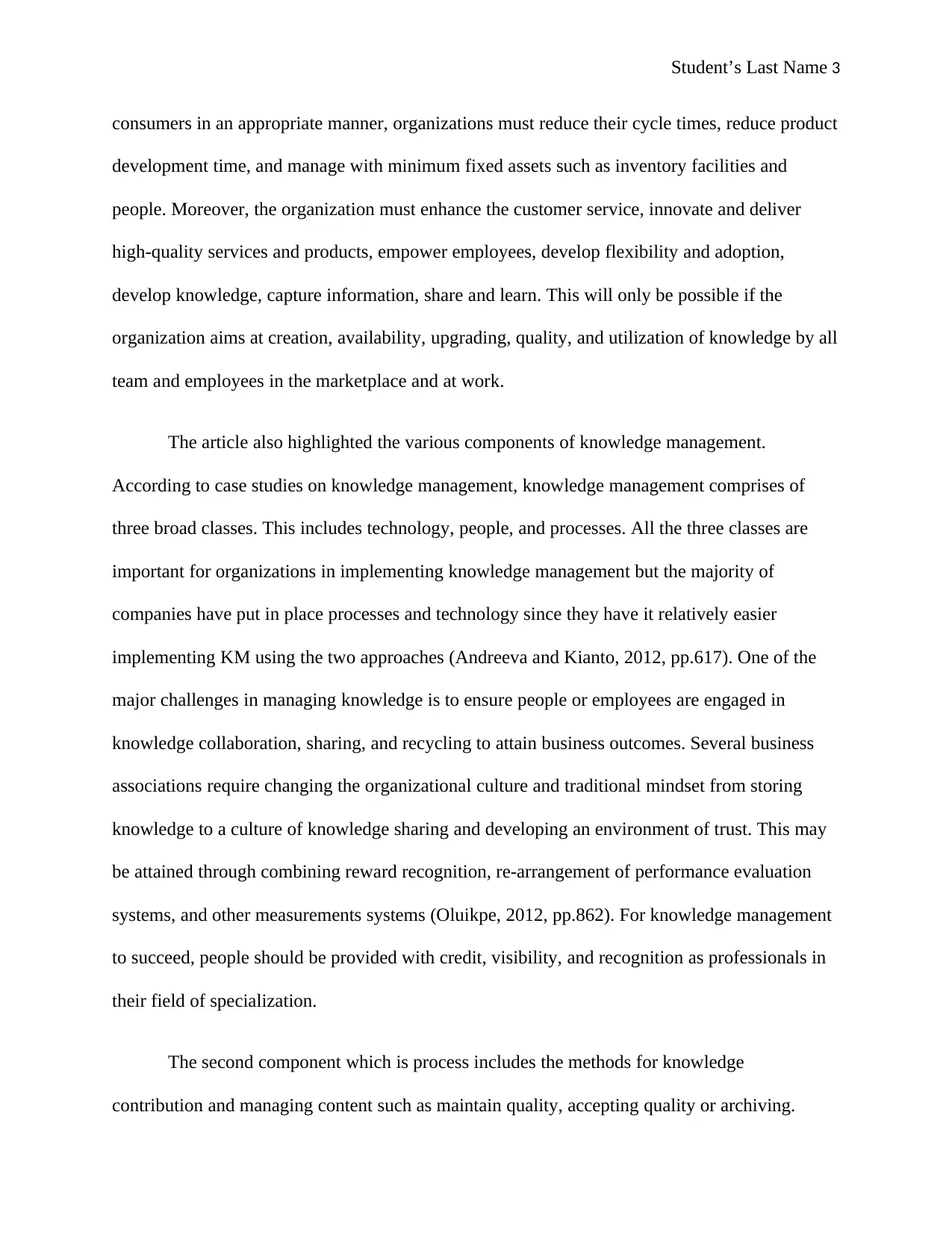
Student’s Last Name 3
consumers in an appropriate manner, organizations must reduce their cycle times, reduce product
development time, and manage with minimum fixed assets such as inventory facilities and
people. Moreover, the organization must enhance the customer service, innovate and deliver
high-quality services and products, empower employees, develop flexibility and adoption,
develop knowledge, capture information, share and learn. This will only be possible if the
organization aims at creation, availability, upgrading, quality, and utilization of knowledge by all
team and employees in the marketplace and at work.
The article also highlighted the various components of knowledge management.
According to case studies on knowledge management, knowledge management comprises of
three broad classes. This includes technology, people, and processes. All the three classes are
important for organizations in implementing knowledge management but the majority of
companies have put in place processes and technology since they have it relatively easier
implementing KM using the two approaches (Andreeva and Kianto, 2012, pp.617). One of the
major challenges in managing knowledge is to ensure people or employees are engaged in
knowledge collaboration, sharing, and recycling to attain business outcomes. Several business
associations require changing the organizational culture and traditional mindset from storing
knowledge to a culture of knowledge sharing and developing an environment of trust. This may
be attained through combining reward recognition, re-arrangement of performance evaluation
systems, and other measurements systems (Oluikpe, 2012, pp.862). For knowledge management
to succeed, people should be provided with credit, visibility, and recognition as professionals in
their field of specialization.
The second component which is process includes the methods for knowledge
contribution and managing content such as maintain quality, accepting quality or archiving.
consumers in an appropriate manner, organizations must reduce their cycle times, reduce product
development time, and manage with minimum fixed assets such as inventory facilities and
people. Moreover, the organization must enhance the customer service, innovate and deliver
high-quality services and products, empower employees, develop flexibility and adoption,
develop knowledge, capture information, share and learn. This will only be possible if the
organization aims at creation, availability, upgrading, quality, and utilization of knowledge by all
team and employees in the marketplace and at work.
The article also highlighted the various components of knowledge management.
According to case studies on knowledge management, knowledge management comprises of
three broad classes. This includes technology, people, and processes. All the three classes are
important for organizations in implementing knowledge management but the majority of
companies have put in place processes and technology since they have it relatively easier
implementing KM using the two approaches (Andreeva and Kianto, 2012, pp.617). One of the
major challenges in managing knowledge is to ensure people or employees are engaged in
knowledge collaboration, sharing, and recycling to attain business outcomes. Several business
associations require changing the organizational culture and traditional mindset from storing
knowledge to a culture of knowledge sharing and developing an environment of trust. This may
be attained through combining reward recognition, re-arrangement of performance evaluation
systems, and other measurements systems (Oluikpe, 2012, pp.862). For knowledge management
to succeed, people should be provided with credit, visibility, and recognition as professionals in
their field of specialization.
The second component which is process includes the methods for knowledge
contribution and managing content such as maintain quality, accepting quality or archiving.
⊘ This is a preview!⊘
Do you want full access?
Subscribe today to unlock all pages.

Trusted by 1+ million students worldwide
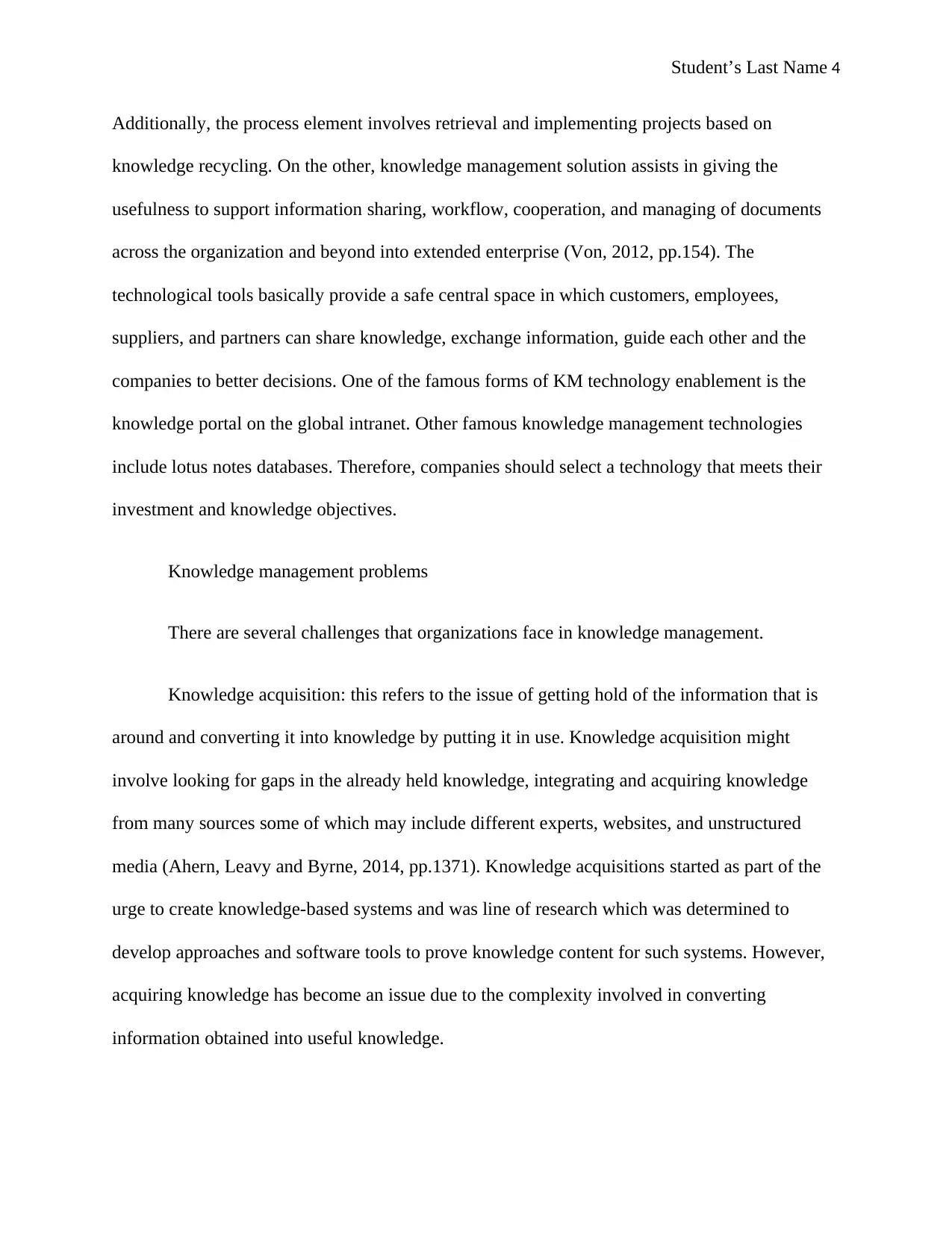
Student’s Last Name 4
Additionally, the process element involves retrieval and implementing projects based on
knowledge recycling. On the other, knowledge management solution assists in giving the
usefulness to support information sharing, workflow, cooperation, and managing of documents
across the organization and beyond into extended enterprise (Von, 2012, pp.154). The
technological tools basically provide a safe central space in which customers, employees,
suppliers, and partners can share knowledge, exchange information, guide each other and the
companies to better decisions. One of the famous forms of KM technology enablement is the
knowledge portal on the global intranet. Other famous knowledge management technologies
include lotus notes databases. Therefore, companies should select a technology that meets their
investment and knowledge objectives.
Knowledge management problems
There are several challenges that organizations face in knowledge management.
Knowledge acquisition: this refers to the issue of getting hold of the information that is
around and converting it into knowledge by putting it in use. Knowledge acquisition might
involve looking for gaps in the already held knowledge, integrating and acquiring knowledge
from many sources some of which may include different experts, websites, and unstructured
media (Ahern, Leavy and Byrne, 2014, pp.1371). Knowledge acquisitions started as part of the
urge to create knowledge-based systems and was line of research which was determined to
develop approaches and software tools to prove knowledge content for such systems. However,
acquiring knowledge has become an issue due to the complexity involved in converting
information obtained into useful knowledge.
Additionally, the process element involves retrieval and implementing projects based on
knowledge recycling. On the other, knowledge management solution assists in giving the
usefulness to support information sharing, workflow, cooperation, and managing of documents
across the organization and beyond into extended enterprise (Von, 2012, pp.154). The
technological tools basically provide a safe central space in which customers, employees,
suppliers, and partners can share knowledge, exchange information, guide each other and the
companies to better decisions. One of the famous forms of KM technology enablement is the
knowledge portal on the global intranet. Other famous knowledge management technologies
include lotus notes databases. Therefore, companies should select a technology that meets their
investment and knowledge objectives.
Knowledge management problems
There are several challenges that organizations face in knowledge management.
Knowledge acquisition: this refers to the issue of getting hold of the information that is
around and converting it into knowledge by putting it in use. Knowledge acquisition might
involve looking for gaps in the already held knowledge, integrating and acquiring knowledge
from many sources some of which may include different experts, websites, and unstructured
media (Ahern, Leavy and Byrne, 2014, pp.1371). Knowledge acquisitions started as part of the
urge to create knowledge-based systems and was line of research which was determined to
develop approaches and software tools to prove knowledge content for such systems. However,
acquiring knowledge has become an issue due to the complexity involved in converting
information obtained into useful knowledge.
Paraphrase This Document
Need a fresh take? Get an instant paraphrase of this document with our AI Paraphraser
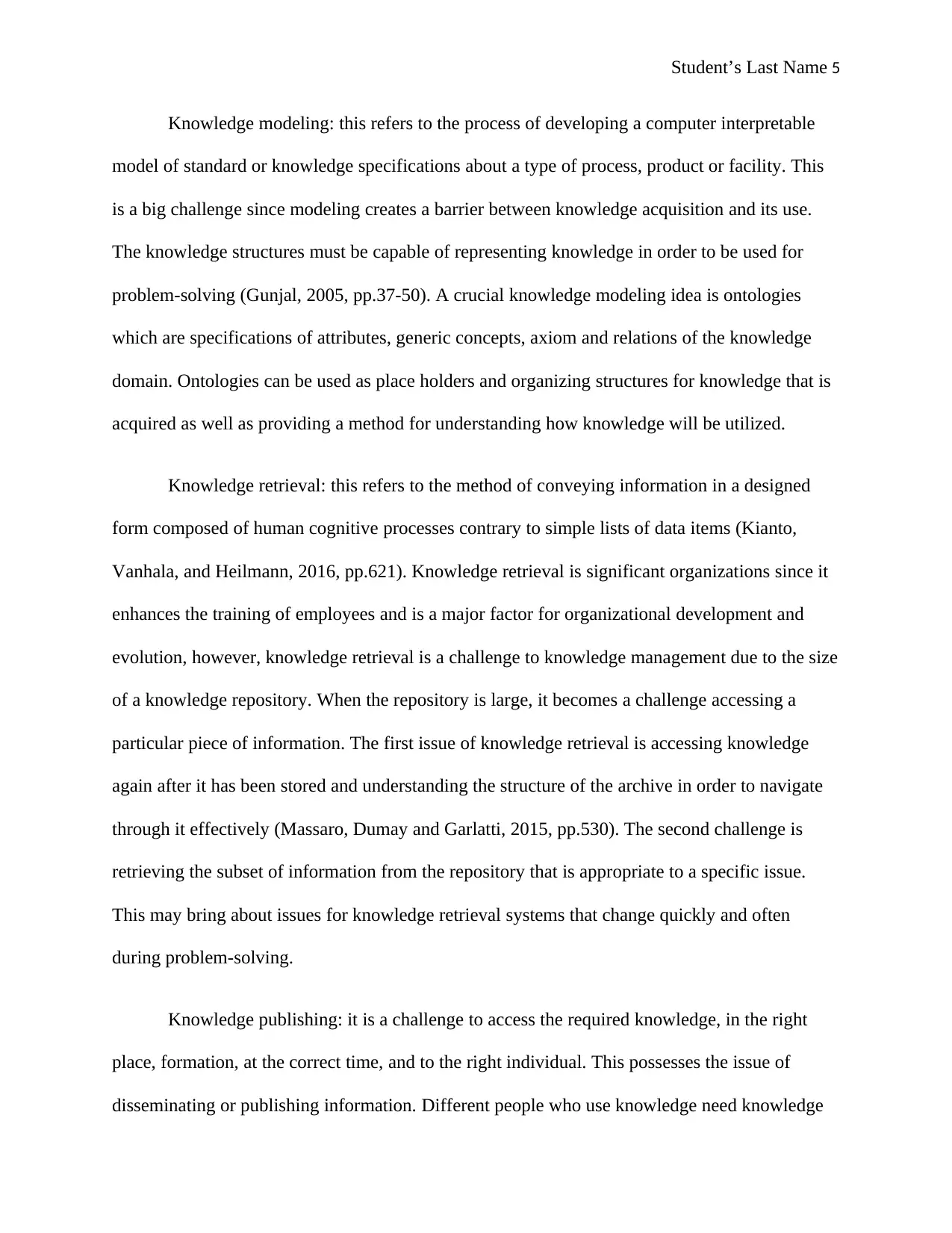
Student’s Last Name 5
Knowledge modeling: this refers to the process of developing a computer interpretable
model of standard or knowledge specifications about a type of process, product or facility. This
is a big challenge since modeling creates a barrier between knowledge acquisition and its use.
The knowledge structures must be capable of representing knowledge in order to be used for
problem-solving (Gunjal, 2005, pp.37-50). A crucial knowledge modeling idea is ontologies
which are specifications of attributes, generic concepts, axiom and relations of the knowledge
domain. Ontologies can be used as place holders and organizing structures for knowledge that is
acquired as well as providing a method for understanding how knowledge will be utilized.
Knowledge retrieval: this refers to the method of conveying information in a designed
form composed of human cognitive processes contrary to simple lists of data items (Kianto,
Vanhala, and Heilmann, 2016, pp.621). Knowledge retrieval is significant organizations since it
enhances the training of employees and is a major factor for organizational development and
evolution, however, knowledge retrieval is a challenge to knowledge management due to the size
of a knowledge repository. When the repository is large, it becomes a challenge accessing a
particular piece of information. The first issue of knowledge retrieval is accessing knowledge
again after it has been stored and understanding the structure of the archive in order to navigate
through it effectively (Massaro, Dumay and Garlatti, 2015, pp.530). The second challenge is
retrieving the subset of information from the repository that is appropriate to a specific issue.
This may bring about issues for knowledge retrieval systems that change quickly and often
during problem-solving.
Knowledge publishing: it is a challenge to access the required knowledge, in the right
place, formation, at the correct time, and to the right individual. This possesses the issue of
disseminating or publishing information. Different people who use knowledge need knowledge
Knowledge modeling: this refers to the process of developing a computer interpretable
model of standard or knowledge specifications about a type of process, product or facility. This
is a big challenge since modeling creates a barrier between knowledge acquisition and its use.
The knowledge structures must be capable of representing knowledge in order to be used for
problem-solving (Gunjal, 2005, pp.37-50). A crucial knowledge modeling idea is ontologies
which are specifications of attributes, generic concepts, axiom and relations of the knowledge
domain. Ontologies can be used as place holders and organizing structures for knowledge that is
acquired as well as providing a method for understanding how knowledge will be utilized.
Knowledge retrieval: this refers to the method of conveying information in a designed
form composed of human cognitive processes contrary to simple lists of data items (Kianto,
Vanhala, and Heilmann, 2016, pp.621). Knowledge retrieval is significant organizations since it
enhances the training of employees and is a major factor for organizational development and
evolution, however, knowledge retrieval is a challenge to knowledge management due to the size
of a knowledge repository. When the repository is large, it becomes a challenge accessing a
particular piece of information. The first issue of knowledge retrieval is accessing knowledge
again after it has been stored and understanding the structure of the archive in order to navigate
through it effectively (Massaro, Dumay and Garlatti, 2015, pp.530). The second challenge is
retrieving the subset of information from the repository that is appropriate to a specific issue.
This may bring about issues for knowledge retrieval systems that change quickly and often
during problem-solving.
Knowledge publishing: it is a challenge to access the required knowledge, in the right
place, formation, at the correct time, and to the right individual. This possesses the issue of
disseminating or publishing information. Different people who use knowledge need knowledge
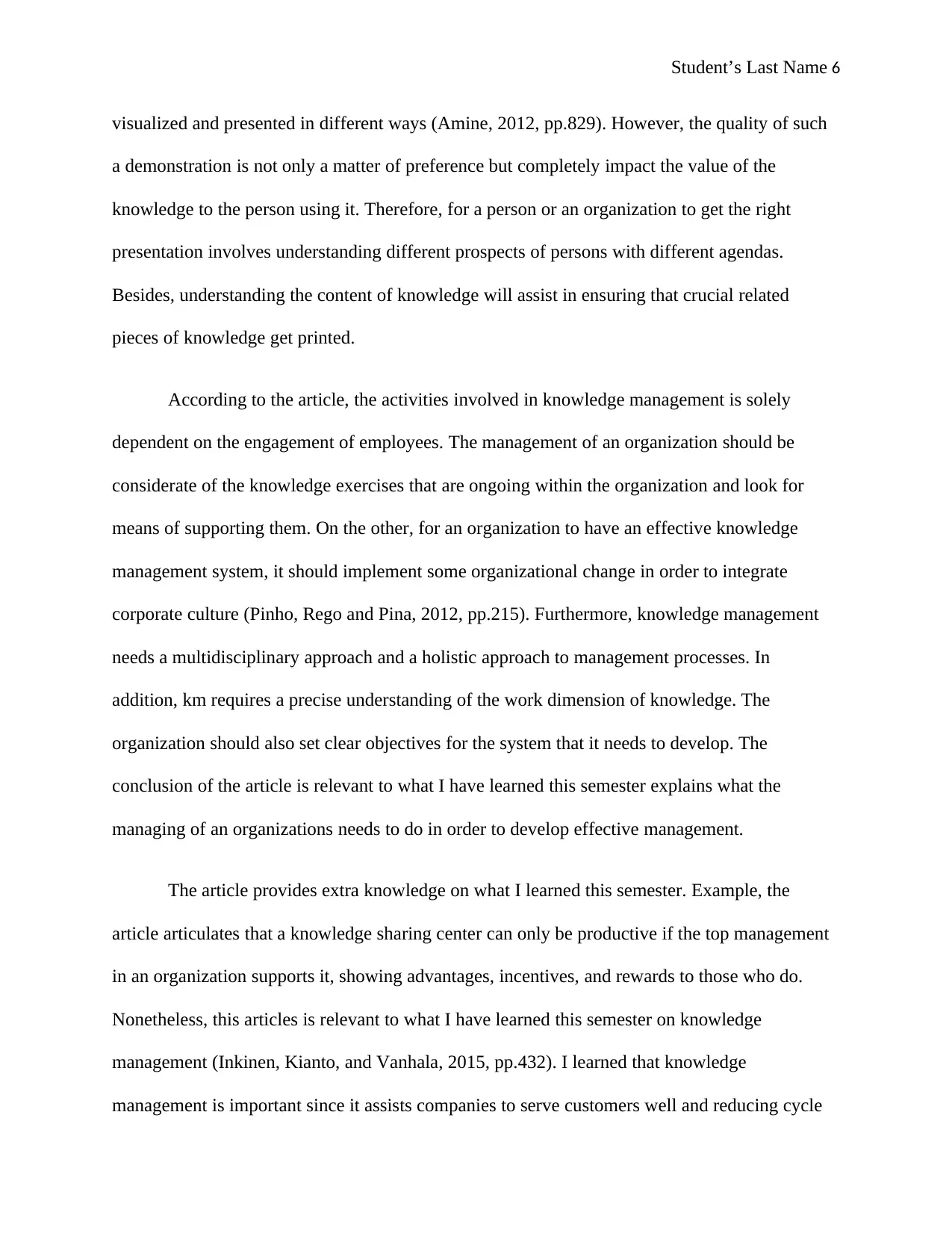
Student’s Last Name 6
visualized and presented in different ways (Amine, 2012, pp.829). However, the quality of such
a demonstration is not only a matter of preference but completely impact the value of the
knowledge to the person using it. Therefore, for a person or an organization to get the right
presentation involves understanding different prospects of persons with different agendas.
Besides, understanding the content of knowledge will assist in ensuring that crucial related
pieces of knowledge get printed.
According to the article, the activities involved in knowledge management is solely
dependent on the engagement of employees. The management of an organization should be
considerate of the knowledge exercises that are ongoing within the organization and look for
means of supporting them. On the other, for an organization to have an effective knowledge
management system, it should implement some organizational change in order to integrate
corporate culture (Pinho, Rego and Pina, 2012, pp.215). Furthermore, knowledge management
needs a multidisciplinary approach and a holistic approach to management processes. In
addition, km requires a precise understanding of the work dimension of knowledge. The
organization should also set clear objectives for the system that it needs to develop. The
conclusion of the article is relevant to what I have learned this semester explains what the
managing of an organizations needs to do in order to develop effective management.
The article provides extra knowledge on what I learned this semester. Example, the
article articulates that a knowledge sharing center can only be productive if the top management
in an organization supports it, showing advantages, incentives, and rewards to those who do.
Nonetheless, this articles is relevant to what I have learned this semester on knowledge
management (Inkinen, Kianto, and Vanhala, 2015, pp.432). I learned that knowledge
management is important since it assists companies to serve customers well and reducing cycle
visualized and presented in different ways (Amine, 2012, pp.829). However, the quality of such
a demonstration is not only a matter of preference but completely impact the value of the
knowledge to the person using it. Therefore, for a person or an organization to get the right
presentation involves understanding different prospects of persons with different agendas.
Besides, understanding the content of knowledge will assist in ensuring that crucial related
pieces of knowledge get printed.
According to the article, the activities involved in knowledge management is solely
dependent on the engagement of employees. The management of an organization should be
considerate of the knowledge exercises that are ongoing within the organization and look for
means of supporting them. On the other, for an organization to have an effective knowledge
management system, it should implement some organizational change in order to integrate
corporate culture (Pinho, Rego and Pina, 2012, pp.215). Furthermore, knowledge management
needs a multidisciplinary approach and a holistic approach to management processes. In
addition, km requires a precise understanding of the work dimension of knowledge. The
organization should also set clear objectives for the system that it needs to develop. The
conclusion of the article is relevant to what I have learned this semester explains what the
managing of an organizations needs to do in order to develop effective management.
The article provides extra knowledge on what I learned this semester. Example, the
article articulates that a knowledge sharing center can only be productive if the top management
in an organization supports it, showing advantages, incentives, and rewards to those who do.
Nonetheless, this articles is relevant to what I have learned this semester on knowledge
management (Inkinen, Kianto, and Vanhala, 2015, pp.432). I learned that knowledge
management is important since it assists companies to serve customers well and reducing cycle
⊘ This is a preview!⊘
Do you want full access?
Subscribe today to unlock all pages.

Trusted by 1+ million students worldwide
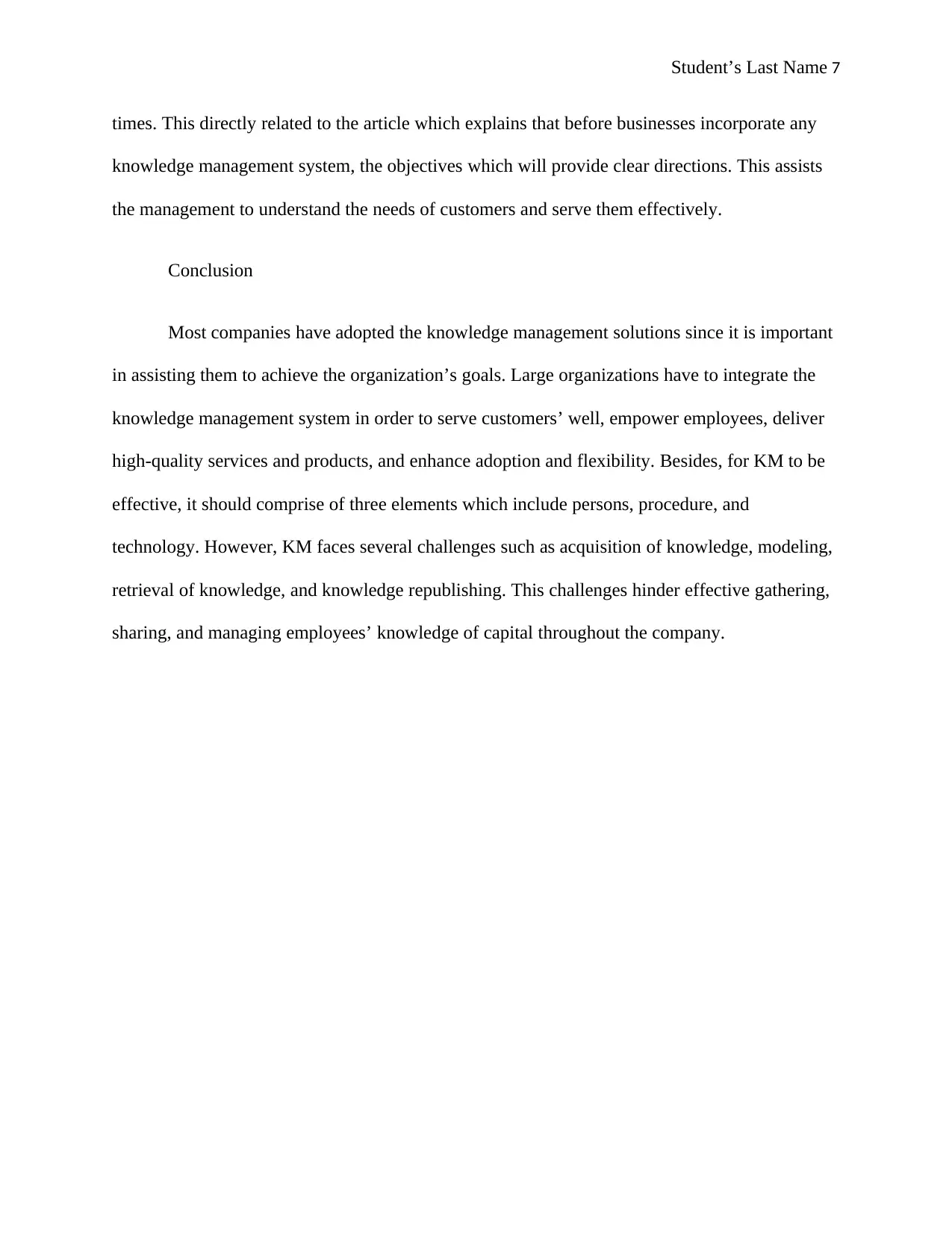
Student’s Last Name 7
times. This directly related to the article which explains that before businesses incorporate any
knowledge management system, the objectives which will provide clear directions. This assists
the management to understand the needs of customers and serve them effectively.
Conclusion
Most companies have adopted the knowledge management solutions since it is important
in assisting them to achieve the organization’s goals. Large organizations have to integrate the
knowledge management system in order to serve customers’ well, empower employees, deliver
high-quality services and products, and enhance adoption and flexibility. Besides, for KM to be
effective, it should comprise of three elements which include persons, procedure, and
technology. However, KM faces several challenges such as acquisition of knowledge, modeling,
retrieval of knowledge, and knowledge republishing. This challenges hinder effective gathering,
sharing, and managing employees’ knowledge of capital throughout the company.
times. This directly related to the article which explains that before businesses incorporate any
knowledge management system, the objectives which will provide clear directions. This assists
the management to understand the needs of customers and serve them effectively.
Conclusion
Most companies have adopted the knowledge management solutions since it is important
in assisting them to achieve the organization’s goals. Large organizations have to integrate the
knowledge management system in order to serve customers’ well, empower employees, deliver
high-quality services and products, and enhance adoption and flexibility. Besides, for KM to be
effective, it should comprise of three elements which include persons, procedure, and
technology. However, KM faces several challenges such as acquisition of knowledge, modeling,
retrieval of knowledge, and knowledge republishing. This challenges hinder effective gathering,
sharing, and managing employees’ knowledge of capital throughout the company.
Paraphrase This Document
Need a fresh take? Get an instant paraphrase of this document with our AI Paraphraser
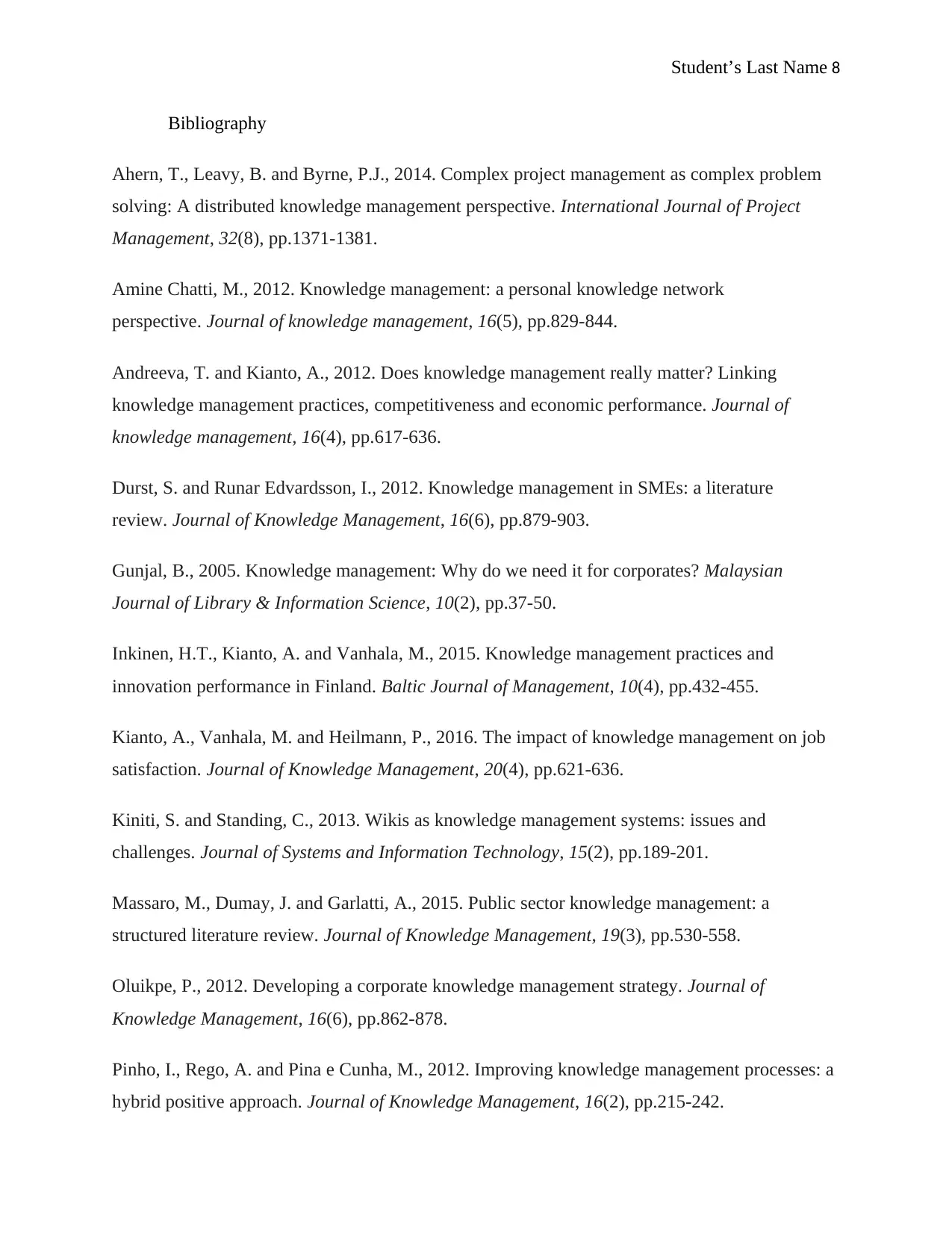
Student’s Last Name 8
Bibliography
Ahern, T., Leavy, B. and Byrne, P.J., 2014. Complex project management as complex problem
solving: A distributed knowledge management perspective. International Journal of Project
Management, 32(8), pp.1371-1381.
Amine Chatti, M., 2012. Knowledge management: a personal knowledge network
perspective. Journal of knowledge management, 16(5), pp.829-844.
Andreeva, T. and Kianto, A., 2012. Does knowledge management really matter? Linking
knowledge management practices, competitiveness and economic performance. Journal of
knowledge management, 16(4), pp.617-636.
Durst, S. and Runar Edvardsson, I., 2012. Knowledge management in SMEs: a literature
review. Journal of Knowledge Management, 16(6), pp.879-903.
Gunjal, B., 2005. Knowledge management: Why do we need it for corporates? Malaysian
Journal of Library & Information Science, 10(2), pp.37-50.
Inkinen, H.T., Kianto, A. and Vanhala, M., 2015. Knowledge management practices and
innovation performance in Finland. Baltic Journal of Management, 10(4), pp.432-455.
Kianto, A., Vanhala, M. and Heilmann, P., 2016. The impact of knowledge management on job
satisfaction. Journal of Knowledge Management, 20(4), pp.621-636.
Kiniti, S. and Standing, C., 2013. Wikis as knowledge management systems: issues and
challenges. Journal of Systems and Information Technology, 15(2), pp.189-201.
Massaro, M., Dumay, J. and Garlatti, A., 2015. Public sector knowledge management: a
structured literature review. Journal of Knowledge Management, 19(3), pp.530-558.
Oluikpe, P., 2012. Developing a corporate knowledge management strategy. Journal of
Knowledge Management, 16(6), pp.862-878.
Pinho, I., Rego, A. and Pina e Cunha, M., 2012. Improving knowledge management processes: a
hybrid positive approach. Journal of Knowledge Management, 16(2), pp.215-242.
Bibliography
Ahern, T., Leavy, B. and Byrne, P.J., 2014. Complex project management as complex problem
solving: A distributed knowledge management perspective. International Journal of Project
Management, 32(8), pp.1371-1381.
Amine Chatti, M., 2012. Knowledge management: a personal knowledge network
perspective. Journal of knowledge management, 16(5), pp.829-844.
Andreeva, T. and Kianto, A., 2012. Does knowledge management really matter? Linking
knowledge management practices, competitiveness and economic performance. Journal of
knowledge management, 16(4), pp.617-636.
Durst, S. and Runar Edvardsson, I., 2012. Knowledge management in SMEs: a literature
review. Journal of Knowledge Management, 16(6), pp.879-903.
Gunjal, B., 2005. Knowledge management: Why do we need it for corporates? Malaysian
Journal of Library & Information Science, 10(2), pp.37-50.
Inkinen, H.T., Kianto, A. and Vanhala, M., 2015. Knowledge management practices and
innovation performance in Finland. Baltic Journal of Management, 10(4), pp.432-455.
Kianto, A., Vanhala, M. and Heilmann, P., 2016. The impact of knowledge management on job
satisfaction. Journal of Knowledge Management, 20(4), pp.621-636.
Kiniti, S. and Standing, C., 2013. Wikis as knowledge management systems: issues and
challenges. Journal of Systems and Information Technology, 15(2), pp.189-201.
Massaro, M., Dumay, J. and Garlatti, A., 2015. Public sector knowledge management: a
structured literature review. Journal of Knowledge Management, 19(3), pp.530-558.
Oluikpe, P., 2012. Developing a corporate knowledge management strategy. Journal of
Knowledge Management, 16(6), pp.862-878.
Pinho, I., Rego, A. and Pina e Cunha, M., 2012. Improving knowledge management processes: a
hybrid positive approach. Journal of Knowledge Management, 16(2), pp.215-242.

Student’s Last Name 9
Von Krogh, G., 2012. How does social software change knowledge management? Toward a
strategic research agenda. The Journal of Strategic Information Systems, 21(2), pp.154-164.
Von Krogh, G., 2012. How does social software change knowledge management? Toward a
strategic research agenda. The Journal of Strategic Information Systems, 21(2), pp.154-164.
⊘ This is a preview!⊘
Do you want full access?
Subscribe today to unlock all pages.

Trusted by 1+ million students worldwide
1 out of 9
Related Documents
Your All-in-One AI-Powered Toolkit for Academic Success.
+13062052269
info@desklib.com
Available 24*7 on WhatsApp / Email
![[object Object]](/_next/static/media/star-bottom.7253800d.svg)
Unlock your academic potential
Copyright © 2020–2025 A2Z Services. All Rights Reserved. Developed and managed by ZUCOL.





